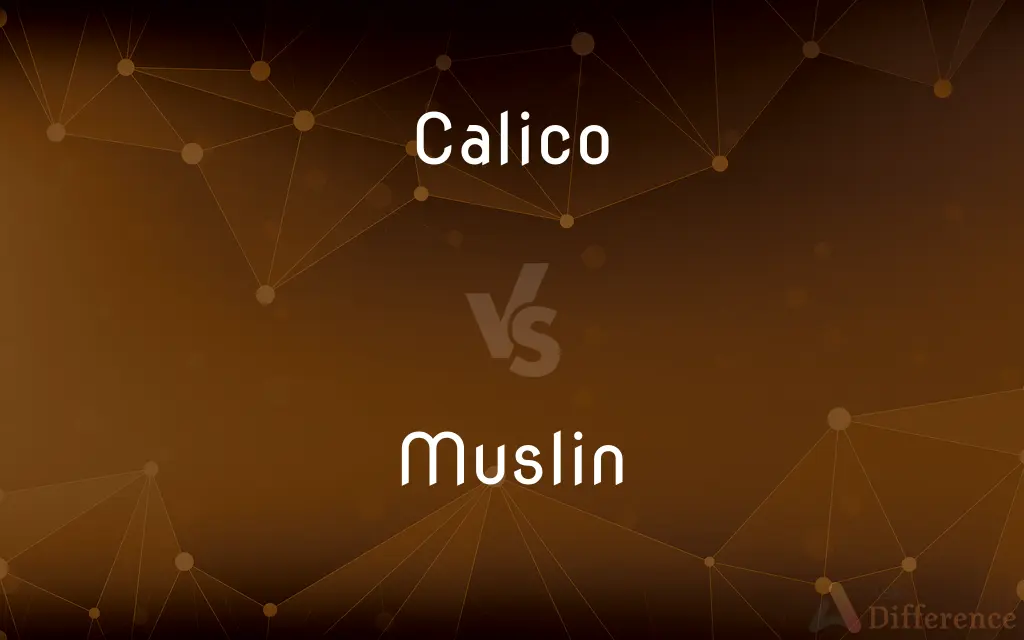Calico vs. Muslin — What's the Difference?
By Tayyaba Rehman & Fiza Rafique — Updated on April 28, 2024
Calico and muslin are both plain-woven textiles; calico is generally printed cotton with a slightly coarse texture, while muslin is softer and finer, often used for dressmaking and curtains.

Difference Between Calico and Muslin
Table of Contents
ADVERTISEMENT
Key Differences
Calico is a cotton fabric that often features a simple, printed design, commonly used for crafts and casual clothing. On the other hand, muslin is known for its softness and fine weave, making it ideal for use in dressmaking, as mock-ups for garments, or even in culinary applications like straining.
Calico is typically less expensive and sturdier, which makes it a popular choice for items like bags, aprons, or quilts. Whereas muslin, with its finer threads and smoother finish, is preferred for delicate tasks, including the creation of summer clothing or as a lightweight curtain material.
In terms of care, calico can generally withstand higher temperatures and more rigorous washing due to its robust nature, while muslin requires gentle handling to maintain its delicate weave and softness.
For crafting, calico is a preferred material as it holds embroidery and appliqué well due to its dense weave. Muslin, on the other hand, is often used in pattern making and dress rehearsals in fashion, as its drapability and light weight offer an accurate representation of the final garment's flow.
When it comes to historical significance, calico was once a highly sought-after commodity in international trade, associated with vibrant prints and colors. Muslin, historically known for its origins in Bengal, was prized for its exceptional softness and was a staple in luxury fashion.
ADVERTISEMENT
Both fabrics serve distinct purposes in textiles; calico is durable and versatile for everyday projects and practical uses, while muslin offers elegance and comfort, preferred for its aesthetic qualities in fine clothing and decor.
Comparison Chart
Texture
Coarser, more durable
Softer, finer weave
Common Uses
Crafts, casual clothing, home décor
Dressmaking, curtains, culinary straining
Price
Generally less expensive
Often more expensive
Care
Can withstand rougher handling
Requires gentle care
Historical Significance
Popular in international trade, vibrant prints
Prized in luxury fashion, originated in Bengal
Compare with Definitions
Calico
Affordable for various craft projects.
Calico is popular in schools for art classes because of its low cost.
Muslin
Ideal for creating prototypes in fashion.
The designer used muslin for the initial mock-up of her gown.
Calico
Used for quilts due to its durability.
The handmade calico quilt became a cherished heirloom.
Muslin
Preferred for delicate culinary tasks.
She used muslin to strain the stock for a clear broth.
Calico
A plain-woven cotton fabric, often printed or dyed.
She sewed a vibrant calico dress for the summer festival.
Muslin
Offers a soft texture suitable for baby clothing.
The newborn's clothes were made from soft muslin to ensure comfort.
Calico
Common in rustic and casual decor.
They decorated the room with calico curtains to add a homey touch.
Muslin
Often used in lightweight summer clothing.
His muslin shirt was perfect for the humid climate.
Calico
Resistant to wear and tear.
Their calico shopping bags could withstand heavy groceries.
Muslin
A fine, lightweight cotton cloth, often unbleached.
The wedding dress was crafted from the finest muslin.
Calico
Calico (; in British usage since 1505) is a plain-woven textile made from unbleached, and often not fully processed, cotton. It may also contain unseparated husk parts.
Muslin
Muslin () is a cotton fabric of plain weave. It is made in a wide range of weights from delicate sheers to coarse sheeting.
Calico
A tightly woven cotton cloth having a repeating, often floral design.
Muslin
Lightweight cotton cloth in a plain weave
She folded the dress in layers of clean muslin
Strain the fruit pulp through a muslin cloth
Calico
Chiefly British A plain white cotton cloth, heavier than muslin.
Muslin
Any of various sturdy cotton fabrics of plain weave.
Calico
An animal, such as a cat, having a coat of white fur with distinct patches of different colors, usually reddish-orange and black.
Muslin
(textile) Any of several varieties of thin cotton cloth.
Calico
(textiles) A kind of rough cloth made from unbleached and not fully processed cotton, often printed with a bright pattern.
Muslin
(US) Fabric made of cotton, flax (linen), hemp, or silk, finely or coarsely woven.
Calico
Ellipsis of calico cat
Muslin
Any of a wide variety of tightly-woven thin fabrics, especially those used for bedlinen.
Calico
(uncountable) The plant disease caused by Tobacco mosaic virus.
Muslin
(US) Woven cotton or linen fabrics, especially when used for items other than garments.
Calico
Made of calico or resembling the color of calico cloth, having a pattern of red and contrasting areas; variegated.
The calico cat had distinctive red and dark markings.
The calico-patterned tablecloths were supposed to make the restaurant look rustic; instead, they made it look run down.
Muslin
(countable) A dressmaker's pattern made from inexpensive cloth for fitting.
Calico
Plain white cloth made from cotton, but which receives distinctive names according to quality and use, as, super calicoes, shirting calicoes, unbleached calicoes, etc.
The importation of printed or stained colicoes appears to have been coeval with the establishment of the East India Company
Muslin
Any of several different moths, especially the muslin moth, Diaphora mendica.
Calico
Cotton cloth printed with a figured pattern.
Muslin
Woman as sex object; prostitute, as in a bit of muslin.
Calico
Made of, or having the appearance of, calico; - often applied to an animal, as a horse or cat, on whose body are large patches of a color strikingly different from its main color.
Muslin
A thin cotton, white, dyed, or printed. The name is also applied to coarser and heavier cotton goods; as, shirting and sheeting muslins. In sheeting, muslin is not as finely woven as percale.
Calico
Coarse cloth with a bright print
Muslin
Plain-woven cotton fabric
Calico
Made of calico or resembling calico in being patterned;
Calico dresses
A calico cat
Calico
Having sections or patches colored differently and usually brightly;
A jester dressed in motley
The painted desert
A particolored dress
A piebald horse
Pied daisies
Common Curiosities
Is muslin good for summer clothing?
Yes, muslin's lightweight and breathable qualities make it ideal for summer apparel.
Can both calico and muslin be dyed?
Yes, both can be dyed, though muslin's finer quality is especially good for delicate shades.
How should I wash muslin compared to calico?
Muslin should be washed gently, unlike calico which can handle more vigorous washing.
Can I use muslin for quilting like calico?
Muslin can be used for quilting, especially as a backing fabric, but it's less common than calico for the quilt top.
What are the historical origins of calico?
Calico originated from Calicut, India, and was heavily traded during the colonial period.
Is calico cheaper than muslin?
Generally, calico is cheaper due to its common production and sturdy nature.
Where does muslin traditionally come from?
Historically, muslin came from Bengal, known for its ultra-fine quality.
What is the main difference between calico and muslin?
Calico is a printed, coarser fabric, while muslin is finer and often used for its softness.
Are calico and muslin suitable for children's clothing?
Calico is good for durable children's wear, while muslin is suitable for soft baby garments.
What are some common uses of calico in home decor?
Calico is frequently used for making drapes, cushions, and slipcovers due to its durability and textured appearance.
Can muslin be used for upholstery like calico?
Muslin is typically too fine for upholstery, which requires a more durable fabric like calico.
What type of printing works best on calico?
Block printing and screen printing are particularly effective on calico due to its texture and absorbency.
How does the wear and tear resistance of muslin compare to calico?
Calico is more resistant to wear and tear, making it suitable for items that require durability, whereas muslin is more delicate.
Share Your Discovery

Previous Comparison
Mahayana vs. Vajrayana
Next Comparison
Retail vs. BulkAuthor Spotlight
Written by
Tayyaba RehmanTayyaba Rehman is a distinguished writer, currently serving as a primary contributor to askdifference.com. As a researcher in semantics and etymology, Tayyaba's passion for the complexity of languages and their distinctions has found a perfect home on the platform. Tayyaba delves into the intricacies of language, distinguishing between commonly confused words and phrases, thereby providing clarity for readers worldwide.
Co-written by
Fiza RafiqueFiza Rafique is a skilled content writer at AskDifference.com, where she meticulously refines and enhances written pieces. Drawing from her vast editorial expertise, Fiza ensures clarity, accuracy, and precision in every article. Passionate about language, she continually seeks to elevate the quality of content for readers worldwide.
















































